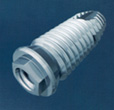
| |
||||
Brånemark Implant® |
 |
|||
|
Abstracts
New
An
Auger Spectroscopic Analysis of Dental Implant Surface Contamination Finite Element Analysis at the Implant/Bone Interface for One-Piece vs Multi-Unit Implant Systems Wang R-F, Kang B, and Lang BR. Finite element analysis at the implant/bone interface for one-piece versus multi-unit implant systems. [Abstract # 2416] J Dent Res 2003;82:B-312. Abstract:
The recent introduction of implant systems that combine the implant
and the abutment as one unit has prompted the question of whether
or not these new systems result in different stresses at the bone
to implant interface when compared with the multi-unit implant systems.
This objective of this study was to measure the stress between the
implant and the bone at specific location for a one-piece implant
compared to a multi-unit implant system when subjected to an off-axis
vertical force using finite element analysis. The Brånemark
Mark III implant, CeraOne abutment and the Unigrip screw were model
for finite element analysis using HyperMesh® software. Similarly,
the assembled implant structure was modeled as a one-piece unit.
A finite element analysis was performed on both models subjected
to a vertical off-axis load of 300 Newtons using ABAQUS® program.
The stress measured within the cortical bone adjacent to the uppermost
threads of both implant systems demonstrated the highest stress
values. Stress measured for the one-piece implant was twice that
of the multi-unit implant complex. An Auger Spectroscopic Analysis of Dental Implant Surface Contamination Investigators: K Stathis, BR Lang, ME Razzoog, and WC Wagner. Abstract:
A key factor in osseointegration of titanium implants has been attributed
to the presence of surface contamination in the “as delivered
state.” The purpose of this study was to examine the surface
of implants from six major implant systems and to assess the presence,
type and amount of surface contaminants following manufacturing.
Five implant obtained from different manufacturing lots for the
following systems formed the experimental population: 1) 3I, 2)
Impla-Med, 3) Brånemark, 4) Steri-Oss, 5) Lifecore –
Restore, and 6) Swede-Vent. Four sites 5 x 5 microns in area were
surveyed from the flat bottom on each implant using Auger electron
spectroscopy (AES). The elements present in the Auger spectra for
each implant system were identified and the surface area of the
contaminants measured. Contaminating elements included carbon, calcium,
sulfur, phosphorus, silicon, boron, chloride, potassium, fluorine,
silver, cobalt, aluminum, antimony, vanadium, nickel and iron. The
Brånemark and Steri-Oss implants exhibited the highest average
surface concentrations of titanium (31.7 and 32% respectively),
and oxygen (31.2 and 34.9% respectively). These implant systems
also demonstrated the lowest amounts of total contaminants (16.7
and 16.2%). The Lifecore – Restore implants had the highest
amount of total contaminants (29.6%) and the lowest average concentration
of titanium (16.8% and oxygen (22.7%). Swede-Vent implants had high
amounts of surface fluorine (7.1%), while the Steri-Oss implants
had high amounts of silicon (5.6%). Examination of the Implant-Abutment Interface After Fatigue Testing Cibirka RM, Nelson SK, Lang BR, and Rueggeberg FA. Examination of the implant-abutment interface after fatigue testing. J Prosthet Dent 2001;268-75. Abstract:
This study was designed to examine potential differences in de-torque
values of abutment screws following fatigue testing when the dimensions
between implant hexagons and abutment hexagons are altered or the
implant hexagonal shape is eliminated. Three experimental Nobel
Biocare implants (n=10) were machined with the conventional hexagonal
(R), modified hexagonal (M) and circular (N) platform geometry.
Thirty Procera® custom abutments with a 25° angulated loading
platform were manufactured. Abutments were retained with Unigrip®
(Nobel Biocare) abutment screws tightened to 32 N/cm. Vertical scribes
across the implant/abutment interface allowed x-y axis evaluation.
An Instron carousel-type fatigue testing device delivered dynamic
loading between 20 and 200 N for 5,000,000 cycles, or approximately
equivalent to 5 years in-vivo mastication through a piston to the
abutment platform. Microscopic and radiographic examination of the
implant/abutment specimens was completed. The abutment screws were
removed and the de-torque values recorded. Bearing surfaces were
examined microscopically. No abutment looseness or x- or y-axis
displacements at the implant/abutment interface were noted. Radiographic
examination demonstrated no indication of screw bending or displacement.
The mean de-torque values for R, M and N were 14.40 N/cm, 14.70
N/cm and 16.40 N/cm respectively. |
||||
|
New
Projects | Origin of the Center
| Implants | Procera
| References Copyright
© 2001 |
||||
